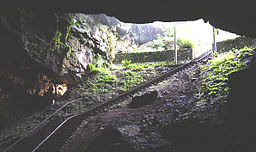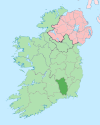- Dunmore Cave
-
Dunmore Cave 
Cave entranceLocation Castlecomer Road, County Kilkenny Length 310 m (1,030 ft)[1] Geology Limestone Number of entrances 1 Access Show cave access only Dunmore Cave (from Irish: Dún Mór meaning "great fort") is a limestone cave in Ballyfoyle, County Kilkenny, Ireland. It is a show cave open to the public, particularly well known for its rich archæological discoveries and for being the site of a Viking massacre in 928.[2]
Contents
Show cave
The caves are located to the east of and close to the N78 Kilkenny–Castlecomer road and about 11 km (6.8 mi) north of Kilkenny City.[3] The entrance is in the townland of Mohill,[1] where a tourist centre has been established at the site. Overlooking the Dinnin river valley, it is found in an isolated outcrop of limestone on the Castlecomer Plateau.[1]
Dunmore is not one of the largest of Ireland's caves. It contains just a quarter of a mile of passages and at its deepest point, it descends to 150 ft (46 m), but it possesses some fine calcite formations. The most spectacular is the Market Cross, a distinctly cross-shaped column over 19 ft (5.8 m) high.
Development
Dunmore Cave was designated a National Monument by the Commissioners of Public Works in 1944,[1][4] but development as a show cave with visitor centre and tours didn't begin until 1967, at the behest of respected archæologist and spelæologist J. C. Coleman. The cave was closed in 2000 for archæological work and redevelopment, and reopened in 2003.[5]
History
The earliest historical reference to the cave is to be found in the Triads of Ireland, dating from the 14th to the 19th century, where "Úam Chnogba, Úam Slángæ and Dearc Fearna" are listed under the heading, "the three darkest places in Ireland".[6] The last, meaning the "Cave of the Alders," is generally thought to be the present Dunmore Cave,[1] while the first two translate as the caves of Knowth and Slaney.[7] Other sources translate the listed locations as Rath Croghan, the cave or crypt of Slane[8] and the "Cave of the Ferns".[7]
In the Annals of the Four Masters, dated to the 17th century, Dearc Fearna was recorded as the site of a great Viking massacre in 928 AD:
"Godfrey, grandson of Imhar, with the foreigners of Ath Cliath, demolished and plundered Dearc Fearna, where one thousand persons were killed in this year as is stated in the quatrain: 'Nine hundred years without sorrow, twenty-eight, it has been proved,
'Since Christ came to our relief, to the plundering of Dearc-Fearna.'"[2]Archæological study
The earliest writings on the cave of an archæological nature came from George Berkeley[9][10] whose report dated 1706 detailed a visit that he made to the cave as a boy. The essay was not published until 1871.[10] In 1869 Arthur Wynne Foot, a physician, made an archæological visit to the cave with Rev. James Graves and Peter Burtchaell and discovered large quantities on human remains, which they collected.[8] In his reports, Foot meticulously documented his findings, and also called references from the writings of researchers over the preceding 120 years.[8]
In 1999, a hoard of 43 silver and bronze items was discovered in a rocky cleft deep in the cave. The hoard was dated to 970 AD. It consisted of silver, ingots and conical buttons woven from fine silver.[11]
References
- ^ a b c d e Coleman, J. C. (1965). The Caves of Ireland. Tralee, Co. Kerry: Anvil Press. pp. 14–16.
- ^ a b O'Donovan, John, ed (1856). "The earliest period to the year 1616". Annals of the Four Masters. II (2nd ed.). Dublin. pp. 624–625. http://www.archive.org/stream/annalsofkingdomo02ocleuoft#page/622. Retrieved 2010-11-06.
- ^ "Heritage Ireland:Dunmore Cave". http://www.heritageireland.ie/en/South-East/DunmoreCave/. Retrieved 2010-10-09.
- ^ Dunnington, N. J.; Coleman, J. C. (1950). "Dunmore Cave, Co. Kilkenny". Proceedings of the Royal Irish Academy 53B: 15–24. JSTOR 20490874.
- ^ "Show Caves of Ireland: Dunmore Caves". http://www.showcaves.com/english/ie/showcaves/Dunmore.html. Retrieved 2010-10-09.
- ^ Meyer, Kuno; Lavelle, Hilary; Purcell, Emer et al., eds (transcribed 2005). The Triads of Ireland. Todd Lecture Series. 13 (1st ed.). Dublin: Hodges, Figgis & Co. http://www.ucc.ie/celt/published/G103006/. Retrieved 2010-11-06.
- ^ a b Meyer, Kuno, ed (1906). The Triads of Ireland. Todd Lecture Series. 13 (1st ed.). Dublin: Hodges, Figgis & Co. pp. 4–5. http://www.archive.org/details/triadsofireland00meyeuoft. Retrieved 2010-11-06.
- ^ a b c Foot, Arthur Wynne (1878). "An account of a visit to the cave of Dunmore, Co. Kilkenny, with some remarks on human remains found therein". Journal of the Royal Society of Antiquaries of Ireland. 4 (Dublin) I: 65–94. http://www.archive.org/stream/journalofroyalso11royauoft#page/65. Retrieved 2010-11-06.
- ^ Hardman, Edward T. (1875–1877). "On Two New Deposits of Human and Other Bones, Discovered in the Cave of Dunmore, Co. Kilkenny". Proceedings of the Royal Irish Academy. Science 2: 168–176. JSTOR 20490001.
- ^ a b Berkeley, George (1901) [1706]. "Description of the Cave of Dunmore". In Fraser, Alexander Campbell. Works of George Berkeley. IV. Oxford: Clarendon Press. pp. 73–84. http://www.archive.org/stream/worksofberkeley04berkuoft#page/73. Retrieved 2010-11-06.
- ^ Buckley, Laureen. "Dunmore Cave – A Viking Massacre Site". http://www.xs4all.nl/~tbreen/PAISN/3-DUNMORE.html. Retrieved 2010-10-09.
Further reading
- Berkeley, George (1901) [1706]. "Description of the Cave of Dunmore". In Fraser, Alexander Campbell. Works of George Berkeley. IV. Oxford: Clarendon Press. pp. 73–84. http://www.archive.org/stream/worksofberkeley04berkuoft#page/73. Retrieved 2010-11-06.
- Coleman, J. C. (1965). The Caves of Ireland. Tralee, Co. Kerry: Anvil Press. pp. 14–16.
- Foot, Arthur Wynne (1878). "An account of a visit to the cave of Dunmore, Co. Kilkenny, with some remarks on human remains found therein". Journal of the Royal Society of Antiquaries of Ireland. 4 (Dublin) I: 65–94. http://www.archive.org/stream/journalofroyalso11royauoft#page/65. Retrieved 2010-11-06.
- Praeger, R. Lloyd (Oct–Nov 1918). "Derc-Ferna: The Cave of Dunmore". Irish Naturalists' Journal 27: 148–158. http://www.archive.org/stream/irishnaturalist27roya#page/148. Retrieved 2010-11-06.
- P. (1 Sep, 1832). "Cave of Dunmore (Kilkenny)". Dublin Penny Journal 1 (10): 73–74. http://www.libraryireland.com/articles/cavedunmore/. Retrieved 2010-11-06.
External links
Places in County Kilkenny County town: Kilkenny Towns Ballyragget · Callan · Castlecomer · Graiguenamanagh · Kilkenny · Mooncoin · Thomastown
Villages Aughamucky · Ballyhale · Bennettsbridge · Carigeen · Castlewarren · Freshford · Galmoy · Goresbridge · Gowran · Hugginstown · Inistioge · Jenkinstown · Johnstown · Johnswell · Kells · Killamery · Killinaspick · Kilmacow · Kilmoganny · Knocktopher · Mullinavat · Paulstown · Piltown · Redhouse · The Rower · Slieverue · Stoneyford · Tullaroan · Urlingford · Windgap
Townlands Ballyda · Cantwell's Court · Flagmount · Hoodsgrove · Jeanville · Loughcullen
List of townlands in County Kilkenny · Category:Mountains and hills of County Kilkenny · Category:Rivers of County Kilkenny · Category:Geography of County Kilkenny Categories:- Show caves
- Limestone caves
- Visitor attractions in County Kilkenny
- National Monuments in County Kilkenny
- Caves of the Republic of Ireland
- Protected areas of County Kilkenny
Wikimedia Foundation. 2010.

